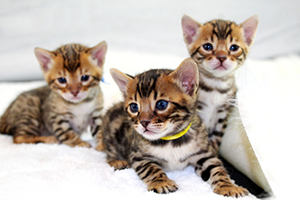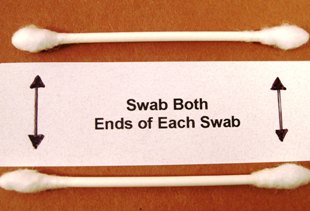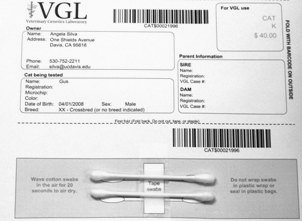Quick Summary
Click here for Price and Turnaround Time
Phenotype: Congenital myasthenic syndrome (CMS) causes a congenital muscle weakness in Devon Rex and Sphynx breed cats. Moderate to severely affected cats show evidence of generalized muscle weakness, particularly following exertion, stress, or excitement. Affected cats frequently adopt a characteristic “dog-begging” or “chipmunk” position, usually with their front legs resting on a convenient object. Signs of the disease can be observed as early as of 3 weeks of age and progress slowly but occasionally do become static.
Mode of Inheritance: Autosomal recessive
Alleles: N = Normal/Unaffected, CMS = Congenital myasthenic syndrome
Breeds appropriate for testing: Devon Rex, Sphynx
Explanation of Results:
- Cats with N/N genotype will not have this congenital myasthenic syndrome. They cannot transmit this CMS variant to their offspring.
- Cats with N/CMS genotype will not have this congenital myasthenic syndrome, but are carriers. They will transmit this CMS variant to 50% of their offspring. Matings between two carriers are predicted to produce 25% congenital myasthenic syndrome-affected kittens.
- Cats with CMS/CMS genotype will have congenital myasthenic syndrome, a progressive condition that can be fatal.
Cat DNA tests are carried out using cells brushed from your cat's cheeks and gums using household cotton swabs.
The cat DNA submission form with instructions and a place to tape the cotton swabs is sent to you via email after you place an order, and can be printed from your home computer. DNA test kits are no longer mailed.
Instructions
Step-By-Step:
1.
 Purchase regular household cotton swabs for cat DNA collection (the cotton swabs can be purchased at a pharmacy or drug store)
Purchase regular household cotton swabs for cat DNA collection (the cotton swabs can be purchased at a pharmacy or drug store)
2.

Make sure the cat has not had anything to eat or drink for at least 1 hour prior to collecting sample.
When swabbing kittens, isolate each kitten from the mother, littermates and any shared toys for 1 hour prior to swabbing. Kittens should not have nursed or eaten for 1 hour prior to collecting sample.
If collecting samples from more than one cat, make sure to sample one cat at a time and wash your hands before swabbing another cat.
3.
 Use both ends of the two cotton swabs for a total of four swabs.
Use both ends of the two cotton swabs for a total of four swabs.
4.
Place the cotton head of the swab between the cat’s gums and cheek and rub or rotate the swab back and forth for 15 seconds. Repeat with each cotton swab head, for a total of 4 swabs. We recommend swabbing a different area of the gums with each swab head.
5.
Wave the swab in the air for 10-15 seconds to air dry it before attaching it to the submission form.
6.
 After swabbing the cheek and gums, tape the cotton swabs to the bar-coded submission form printed from your MyVGL account.
After swabbing the cheek and gums, tape the cotton swabs to the bar-coded submission form printed from your MyVGL account.
ATTENTION:
- Do not collect saliva/drool – the key to obtaining a good sample is getting cheek cells on the swab.
- Do not rub swab on the cat’s tongue or teeth – this will result in poor quality sample.
- Do not collect a sample from a kitten that has recently nursed – the mother’s genetic material can rub off on the kitten’s mouth and contaminate the sample.
A mutation that causes a congenital muscle weakness in Devon Rex and Sphynx breed cats, initially reported as “Spasticity”, has been identified in the gene COLQ. The mutation results in a congenital myasthenic syndrome (CMS) similar to CMS in humans. The disease is inherited in an autosomal recessive fashion thus two copies of the mutation are necessary to observe the disease and both males and females are equally affected. Cats with a single copy are unaffected but are carriers.
Moderate to severely affected cats show evidence of generalized muscle weakness, particularly following exertion, stress, or excitement. Affected cats frequently adopt a characteristic “dog-begging” or “chipmunk” position, usually with their front legs resting on a convenient object. Cats with CMS generally succumb to the disease by asphyxiation due to choking on food or aspiration pneumonia by two years of age. Signs of the disease can be observed as early as of 3 weeks of age and progress slowly but occasionally do become static.
The disease was first described in the UK in 1989 with detailed presentations from Australia in 1993. Affected cats have been identified in the USA and more recently across Europe. Breeding two carrier cats is predicted to produce 25% affected offspring.
The mutation causing Sphynx and Devon Rex Congenital Myasthenic Syndrome was discovered by a world-wide research team of geneticists and neurologists from the University of Missouri, the University of California, Davis, the University of California, San Diego, the University of Sydney, and the University of Milan.
Acknowledgements
We appreciate the assistance of Nicholas Gustafson, the strong and long-standing dedication of cat breeders, Sybil Drummond and Pam Dowlings, Paolo Valiati, and the Italian Feline Biobank-Vetogene.
Research Funding
Funding was provided by the National Center for Research Resources R24 RR016094, the Winn Feline Foundation (W10 -014 , W11-041, MT13-010), the Phyllis and George Miller Trust (MT08-015), the University of California, Davis, Center for Companion Animal Health (2008-36-F, 2008-06-F) and the Cat Health Network (D12FE-510).
